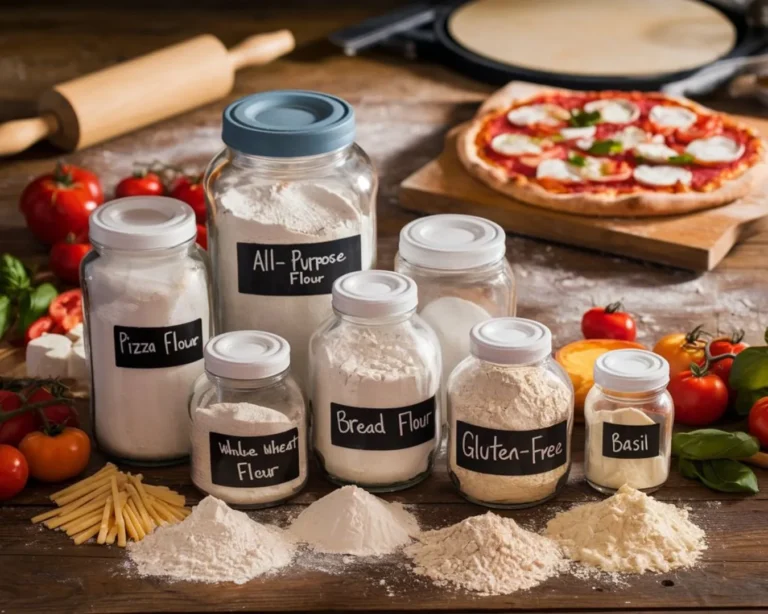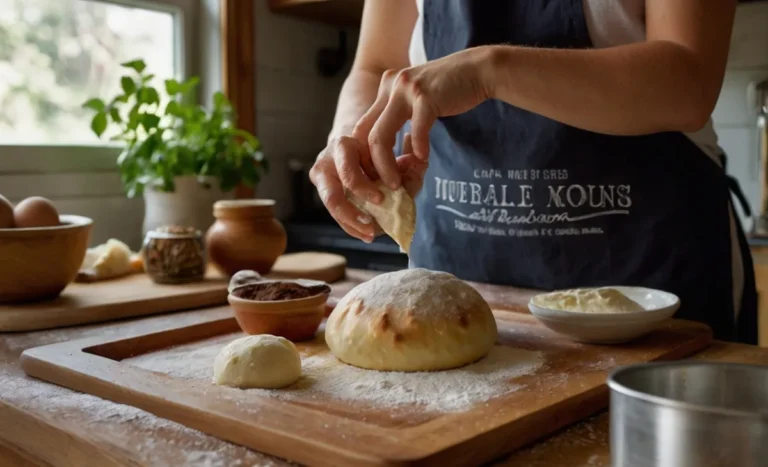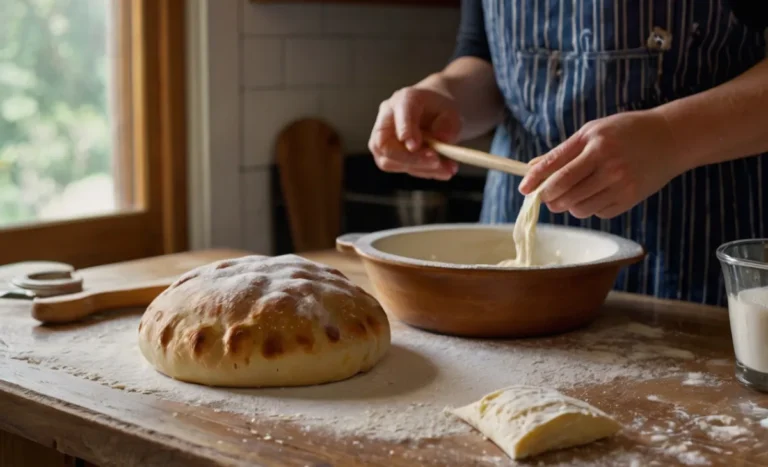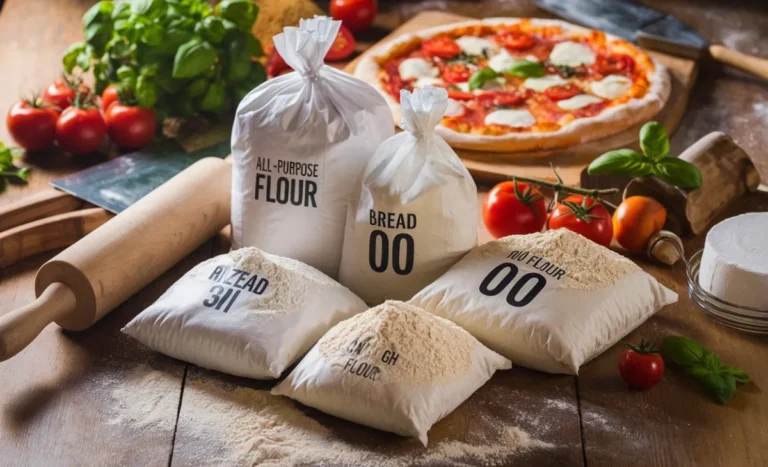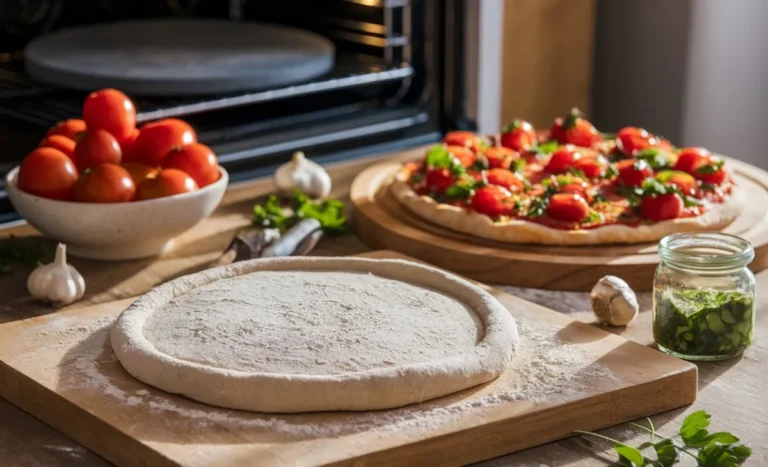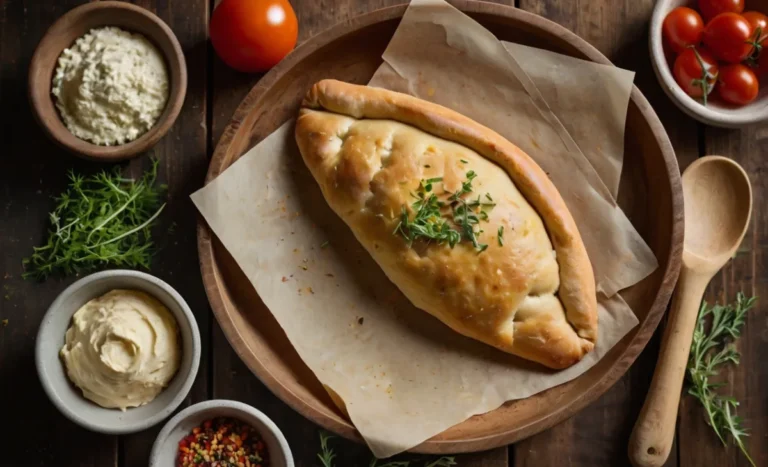The Best Types of Pizza Flour: A Comprehensive Guide for Home Bakers
Introduction to Pizza Flour: Understanding the Basics
Understanding pizza flour is essential for any home baker aiming to create the perfect crust. Unlike regular all-purpose flour, pizza flour has a specific protein content that affects the dough’s texture and elasticity. This key characteristic allows for a chewy yet crispy crust, making it ideal for various pizza styles. By mastering the basics of pizza flour, you can elevate your homemade pizzas to a whole new level.
There are several types of pizza flour, each suited for different baking methods and preferences. The most common types include “00” flour, bread flour, and all-purpose flour. Each type has unique properties that influence the final result. For instance, “00” flour is finely milled and offers a delicate texture, perfect for Neapolitan-style pizzas. Meanwhile, bread flour provides higher protein levels, resulting in a chewier crust that works well for New York-style pizzas.
In addition to the type of flour, hydration levels and kneading techniques also play crucial roles in dough preparation. A well-hydrated dough yields a lighter, airier crust, while proper kneading develops gluten, which enhances elasticity. Understanding these factors can help you make informed choices about your pizza flour, leading to better results.
Ultimately, selecting the right pizza flour is the foundation of a successful pizza-making experience. As you dive into the various options available, keep in mind how each type can influence your final product. This guide will help you explore the best types of pizza flour, enabling you to bake pizzas that impress your family and friends.
Types of Pizza Flour: A Breakdown of Options
When it comes to pizza flour, understanding the different types can significantly impact your baking results. Each type offers unique characteristics that cater to various pizza styles and preferences. This breakdown will help you navigate your options, making it easier to choose the best flour for your next homemade pizza.
One popular choice is “00” flour, often hailed as the gold standard for Neapolitan-style pizza. This finely milled flour has a low protein content, usually around 8-12%, which results in a soft and elastic dough. Because of its fine texture, “00” flour creates a beautifully tender crust that cooks quickly in high-temperature ovens. As a result, this flour is perfect for achieving that classic pizzeria-quality pizza at home.
Another excellent option is bread flour, which contains a higher protein content, typically between 12-14%. This flour is ideal for creating a chewy, robust crust, making it perfect for New York-style pizza or thick-crust varieties. The increased gluten development in bread flour contributes to a hearty structure, allowing the dough to hold up well under various toppings. If you prefer a more substantial pizza, bread flour is the way to go.
Lastly, all-purpose flour is a versatile option that many home bakers already have on hand. With a moderate protein content of about 10-12%, it can yield decent results for various pizza styles. While it may not produce the same texture as “00” or bread flour, all-purpose flour is convenient for those new to pizza-making. By experimenting with these different types of pizza flour, you can discover which one best suits your baking style and desired pizza outcome.
The Science Behind Pizza Flour and Dough Texture
Understanding the science behind pizza flour and dough texture is essential for achieving the perfect pizza. Flour plays a crucial role in dough development, impacting both the structure and flavor of your crust. The protein content in pizza flour determines how much gluten can be formed during mixing and kneading. Gluten gives the dough its elasticity and strength, allowing it to rise and stretch without tearing.
Different types of pizza flour have varying protein levels, which directly affect dough texture. For example, “00” flour, with its lower protein content, produces a softer dough ideal for Neapolitan-style pizzas. This flour creates a tender crust that cooks quickly in high heat, allowing for a beautifully charred finish. In contrast, bread flour’s higher protein content results in a chewier texture, making it suitable for thicker crusts like New York-style pizza. By choosing the right flour, you can achieve the desired texture for your specific pizza style.
Hydration also plays a significant role in the science of pizza dough. The amount of water added to your dough affects its consistency and final texture. Higher hydration levels typically lead to a lighter, airier crust, while lower hydration yields a denser texture. It’s essential to find the right balance for the type of pizza flour you are using, as each flour behaves differently when mixed with water. Experimenting with hydration can help you discover the ideal texture for your homemade pizza.
Finally, kneading and fermentation further contribute to the overall texture of your pizza dough. Kneading develops gluten strength, ensuring the dough can hold its shape during baking. Meanwhile, fermentation allows flavors to develop and the dough to rise. The combination of these elements creates a pizza crust that is not only delicious but also has the perfect texture. By understanding the science behind pizza flour and dough texture, you can refine your pizza-making skills and produce exceptional results every time.
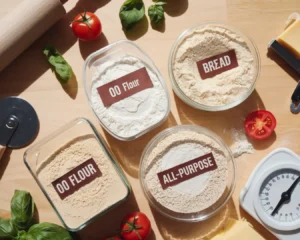
How to Choose the Right Pizza Flour for Your Style
Choosing the right pizza flour is essential for achieving the perfect crust that suits your preferred style. With various types of pizza flour available, understanding their characteristics will help you make an informed decision. Factors such as protein content, texture, and flavor all play significant roles in determining which flour best fits your needs. By assessing these elements, you can elevate your homemade pizza experience.
First, consider the type of pizza you want to create. For classic Neapolitan pizza, “00” flour is an excellent choice due to its finely milled texture and low protein content. This flour allows for a soft and elastic dough that cooks quickly in high-temperature ovens. On the other hand, if you prefer a chewier crust like New York-style pizza, opt for bread flour, which has a higher protein content. This flour provides the strength needed for a thick, hearty crust that can hold various toppings.
Additionally, think about your baking method. If you plan to use a pizza stone or a wood-fired oven, “00” flour can help you achieve the authentic pizzeria experience. Conversely, if you’re baking in a standard home oven, bread flour may yield better results. The choice of pizza flour can significantly impact the final texture, so aligning it with your cooking method is crucial.
Finally, don’t hesitate to experiment with different blends to find your ideal pizza flour mix. Many bakers enjoy combining all-purpose flour with specialty flours for unique textures and flavors. By trying various combinations, you can discover new depths of taste and crust quality. Ultimately, understanding how to choose the right pizza flour for your style will enhance your pizza-making skills and result in delicious creations every time.
Top Brands of Pizza Flour: Recommendations and Reviews
When selecting pizza flour, choosing the right brand can make a significant difference in your baking results. With numerous options available, it’s essential to explore top brands known for their quality and performance. This guide will highlight some of the best pizza flour brands, along with recommendations and reviews to help you make informed decisions.
One popular brand among home bakers is Caputo, renowned for its “00” flour. This Italian flour is finely milled and has a protein content of around 11.5%. Many users appreciate its ability to create a soft, elastic dough that produces a light, airy crust. Additionally, Caputo flour is perfect for high-temperature baking, making it ideal for Neapolitan pizzas. Many bakers rave about the authentic flavor and texture it imparts, consistently recommending it for serious pizza enthusiasts.
Another excellent option is King Arthur Baking Company, which offers a versatile bread flour. With a protein content of about 12.7%, this flour is perfect for creating a chewy crust. Home bakers frequently praise King Arthur for its consistent quality and performance. Users have noted that it works well in various pizza styles, from New York to Chicago deep-dish. This brand’s reputation for reliable ingredients makes it a favorite among many.
Finally, Bob’s Red Mill provides a high-quality all-purpose flour that can be used for pizza-making. While it may not offer the same specialized properties as “00” or bread flour, its versatility is appealing. Many bakers appreciate its organic and whole grain options, which add a unique flavor to the crust. Users often highlight the quality of Bob’s Red Mill flour, noting that it produces satisfactory results in various pizza recipes. By considering these top brands of pizza flour, you can confidently enhance your baking experience and create delicious homemade pizzas.
Common Mistakes When Using Pizza Flour
Using pizza flour effectively is crucial for achieving the perfect crust, but many home bakers make common mistakes. These errors can lead to disappointing results, such as tough or bland pizza. By understanding these pitfalls, you can improve your pizza-making skills and enjoy better outcomes every time you bake.
One frequent mistake is not measuring flour correctly. Many bakers use the scoop method, which can lead to inconsistent amounts. Instead, it’s essential to use a kitchen scale for precision. By weighing your pizza flour, you ensure the correct hydration levels and achieve the desired dough consistency. This small adjustment can significantly enhance your pizza-making process.
Another common error involves using the wrong type of pizza flour for your recipe. Each flour type has unique characteristics, and using the incorrect one can affect texture and flavor. For instance, substituting “00” flour with all-purpose flour may result in a denser crust. It’s important to match your flour choice with the specific pizza style you want to create. By doing so, you can enjoy the best possible results.
Lastly, many bakers neglect proper dough handling techniques. Over-kneading or under-kneading can impact gluten development and texture. Additionally, failing to allow adequate resting time can hinder the dough’s ability to rise and stretch. Therefore, pay attention to these techniques to maximize the potential of your pizza flour. By avoiding these common mistakes, you can elevate your pizza-making skills and delight your friends and family with delicious homemade pizzas.
Tips for Storing and Using Pizza Flour Effectively
Storing and using pizza flour effectively is essential for maintaining its quality and ensuring excellent baking results. Proper storage not only extends the shelf life of your flour but also preserves its flavor and performance. By following a few simple tips, you can maximize the potential of your pizza flour and enjoy delicious homemade pizzas.
First, store your pizza flour in an airtight container to keep it fresh. Exposure to air can lead to moisture absorption, which may cause clumping or spoilage. Glass or plastic containers with tight-fitting lids are ideal for this purpose. Additionally, consider keeping your flour in a cool, dry place, away from direct sunlight and heat sources. These precautions will help maintain the quality of your pizza flour for an extended period.
When it comes to using pizza flour, measuring accurately is crucial for achieving the desired dough consistency. Using a kitchen scale allows you to weigh your flour, ensuring precise measurements for your recipes. This accuracy will help you maintain proper hydration levels and improve dough texture. Furthermore, if you plan to experiment with different flours, keeping a journal of your measurements and results can be beneficial for future reference.
Lastly, remember to check the expiration date on your pizza flour before use. Even if stored properly, flour can lose its potency over time. If you notice any off smells or discoloration, it’s best to discard the flour. Regularly refreshing your stock will ensure you always have high-quality pizza flour on hand. By implementing these tips for storing and using pizza flour effectively, you can enhance your pizza-making experience and create exceptional homemade pizzas.
How to Make a Creamy Rotel Dip Recipe That Will Impress Your Guests


